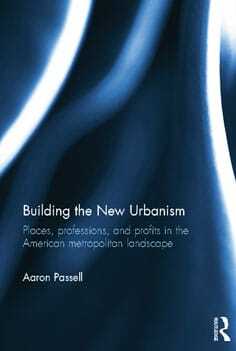Building the New Urbanism: Places, Professions, and Profits in the American Metropolitan Landscape
Aaron Passell
Routledge
711 Third Avenue, New York, NY 10017
www.routledge.com.
2013. 160 pages. Hardback: $125.00.
New urbanism’s rise has been a quiet revolution—a gradual introduction of walkability and outdoor rooms into the vocabulary of urban development. Today, its charrettes and form-based codes seem like a given for planners, designers, and developers. How did this seemingly radical movement overturn the entrenched order of single-use Euclidean zoning, conventional large-lot subdivisions, and citizen resistance to mixed uses and higher density?
The new urbanism movement blends the seemingly incompatible values of creating community and profiting from growth, of traditional small-town design and 21st-century lifestyles. To understand how these apparently opposed values could work together, it is necessary to deconstruct the unique American landscape that originated in the suburban development tsunami unleashed by pent-up housing demand following World War II.
In his book Building the New Urbanism, Aaron Passell does a masterful job of explaining the growth of this approach to urban design. A Furman University sociology professor, he might seem an unlikely candidate to unravel the complicated mix of places, professions, and profits that determined the American metropolitan landscape. But his cogent account is one of the best published explanations of why new urbanism occurred when it did.
Passell, an “old urbanite” skeptical about the possibility of creating new places and building community, strives to maintain his objectivity. He describes his first visit to new urbanist Seaside, Florida, almost as if he is a visitor from another planet, curiously encountering the town’s white picket fences, quirky modernist architecture, and narrow streets. He goes on to discuss new urbanism’s ups and downs, but in the end he cannot conceal his admiration for its ultimate success as a social process. To Passell, it is not a revolution, but a “pragmatic realignment” that functions within the private real estate market to challenge the homogeneity of suburbia and its segregation of land uses.
The postwar suburban real estate boom created the conditions that ultimately would allow that realignment. Seven familiar factors reinforced the boom: federal mortgage policy, the rise of big builders, interstate highway construction, federal tax policy, diverging attitudes toward suburban culture, urban renewal, and municipal exclusionary zoning. Each harbored the seeds of its own transcendence, including frustration with traffic, concern with the environmental impacts of sprawl, an overabundance of malls, NIMBYism, and boredom with swaths of “ticky-tack” housing, as well as irresponsible mortgage lending that would fuel the eventual market crash. These conditions constituted a ripe setting for a new approach.
First, however, advocates of new urbanism had to recruit architects, urban planners, and real estate developers to their cause. For architects to join the fold, they had to overcome their profession’s commitment to unbridled artistic freedom and the single sculptural building. The charrette—a collaborative, deadline-driven design workshop—played to a generation of architects disaffected by commercial practice.
To bring in planners, new urbanists had to facilitate planners’ continued control over the development approval process. Form-based code, a new type of development regulation based on new urbanist design principles, gave planners a stake.
To bring in developers, new urbanists needed to show that new urbanist projects would be profitable. The first neotraditional projects convinced real estate developers that the movement made sense by demonstrating that homebuyers would pay extra to live in a new urbanist community.
The path-breaking project was Kentlands, an 1,800-home development in Gaithersburg, Maryland. During Kentlands’ planning and construction, new urbanism went from a set of principles to a new model for the American community. Andrés Duany, the Pied Piper of new urbanism, and his team during 1988 designed Kentlands in a weeklong charrette that, Passell writes, “cut the Gordian knot of land use zoning, housing finance, and NIMBYism” by bringing all the stakeholders together.
The developer, Joseph Alfandre, charmed by Duany, strongly supported his new urbanist principles. Kentlands residents went to bat for the design, demanding that the Gaithersburg Planning Commission reduce its conventional parking requirements for their recreation center. Completed in 2001, Kentlands went from a design vision to an actual place—walkable, dense, and attractive to homebuyers looking for an alternative to the conventional subdivision.
Building the New Urbanism is basically an academic book. The analysis of the new urbanism movement is based on the work of French sociologists Pierre Bourdieu and Bruno Latour, and the book includes an extensive discussion of the social factors underlying construction of the built environment. The text is dense and the graphics are limited to a few black-and-white photographs. But the underlying story of the emergence of new urbanism is powerfully conveyed.
Readers expecting more information on the full range of contemporary new urbanist projects beyond Kentlands must look elsewhere. However, for those wanting to understand how the movement managed to overturn old-line urban planning, design, and development practice, including entrenched single-use zoning with large lots and excessive parking, this is the book to read. It ties all the pieces together in a way that open will your eyes.





